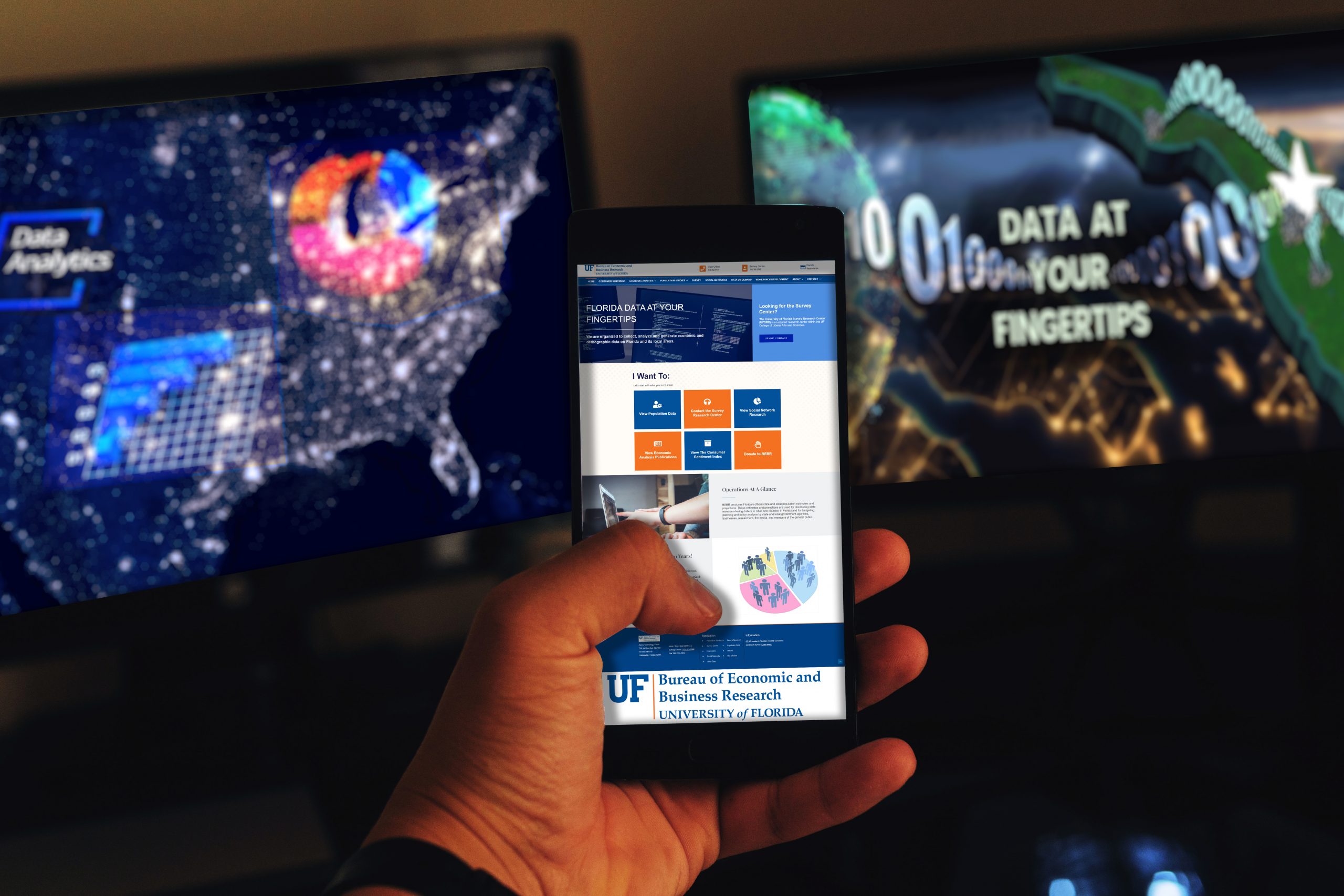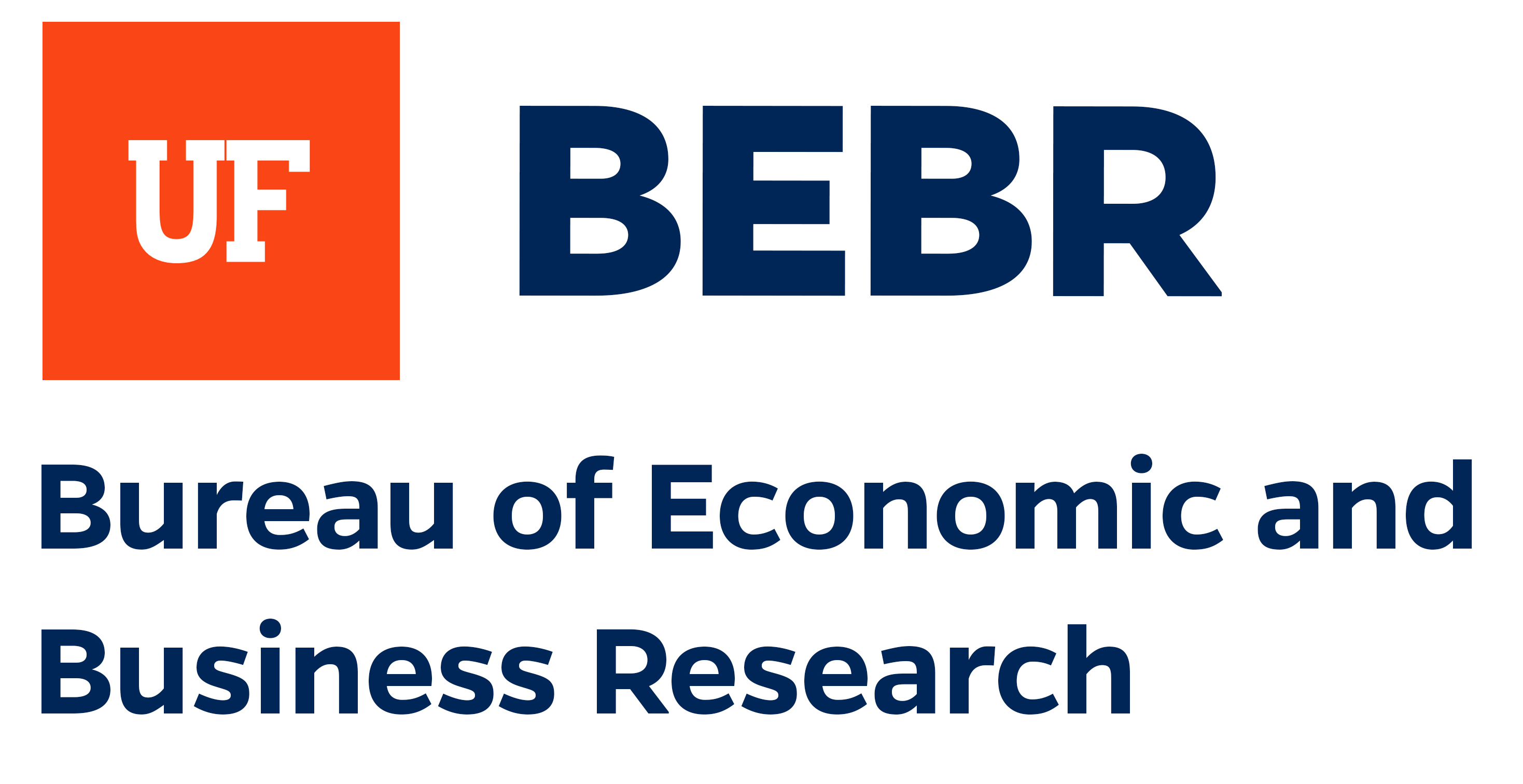
Social Networks Blog
BEBR was founded in 1930 and is part of the UF College of Liberal Arts and Sciences.
BEBR published the Florida Statistical Abstract each year from 1967 to 2011. This award-winning research volume of statistical data about Florida is the leading source of data on Florida and its cities and counties, providing information on population, housing, employment, income, education, health, tourism, elections, and much more.
BEBR continues to offer the same kind of data services today!
(more…)
Uncategorized
Part I: Combining Networks From Publication And Grant Activity
Collaborations on publications and grants among UF researchers generate two different social networks. Their union gives us the most accurate and comprehensive picture of the UF scientific network available in the data. In the “union” network, relations can represent collaborations on a grant, a publication, or both. The position of specific actors, such as patent authors, and the relations among them, can be highlighted in the network.
Part II: Collaboration Metrics Based On Network-Level Measures Of Cohesion
Measures of network cohesion and distance show that the UF scientific network became more cohesive, that is, the overall tendency to scientific collaboration increased in the university over 2008-2012. During the same years, the CTSI came to cover an increasingly large part of the UF network, and distances between UF scientists became gradually lower.
Part III: Collaboration Metrics Based On Node-Level Measures Of Centrality
Different metrics can be used to assess the centrality of researchers in the UF scientific community. Degree centrality is the number of collaborators a researcher has, that is, his degree of connectedness to the network. Betweenness centrality is a measure of brokerage, as it quantifies the extent to which a researcher falls on the network paths between other researchers, and is a bridge between separate areas of the network. Closeness centrality measures the extent to which a scientist is close to every other actor, and can easily reach to the rest of the network. Researchers in the CTSI show higher centrality values on average on all these measures in 2008-2012, in both the publication and grant networks, compared to researchers outside the CTSI. In other words, the CTSI gathers some of the most central UF scientists, who tend to be better connected to the university scientific network, more often located in brokering positions between different research groups, and able to more easily reach to other UF scientists to whom they are not directly connected.
Part IV: Collaboration Metrics Based On Diversity Of Actor Attributes
In our scientific networks, the neighborhood of a researcher is the set of all his collaborators in a year. Thus, the degree of department, college or discipline diversity in a researcher’s neighborhood measures the extent to which that researcher engages in interdisciplinary research. CTSI researchers show a higher neighborhood diversity on average over 2008-2012, which means that the CTSI has functioned as a hub for interdisciplinary research at UF in the last years. This is confirmed by the higher number of authors per publication and investigators per grant in the CTSI, compared to the rest of the university. Finally, the CTSI exhibits a prevalence of “open triads” of researchers, as opposed to closed triads, over the years. As open triads tend to connect separate and distant areas of the network, this structural feature of the CTSI network suggests as well an increasing diversity of backgrounds, methods, and substantive topics in CTSI research activities.
Uncategorized
Social Network Analysis is not just about describing and explaining networks, it is also about using networks for specific interventions with specific goals. Network interventions have traditionally been designed and tested in the health sciences to block contagions or spread healthy practices, and in management and business administration to improve the economic performance of organizations. We explored ways of intervening on research collaboration networks to improve the scientific productivity of a university.
Part I: Why Intervening On A Scientific Network
A scientific network is like a brain: new connections create new ways the whole system thinks and operates. However, when researchers are simply encouraged to pick collaborators for a project (for example, by a traditional Request for Applications by a research funding agency), they tend to collaborate in their comfort zone, that is, to reproduce existing connections in the network by working with previous or anyway close collaborators. Implementing a network intervention on a scientific network means creating new links that cross scientific comfort zones. Moreover, researchers who create links, that is, collaborations, in a scientific network are rarely aware of the whole network structure. On the other hand, by mapping this structure and creating network-aware collaborations, we can create specific new links that enhance specific properties of a university’s scientific network.
Part II: A Survey To Collect Researchers’ Reactions
Based on the structure of the UF scientific network, and on specific network criteria, we identified new links (collaborations) that would be potentially successful, foster interdisciplinary exchange, and enhance certain properties of the whole network. We interviewed the potential collaborators we identified, and collected their views on the possibility of succesfully working with each other.
Uncategorized
Social Network Analysis (SNA) is a methodology and a theoretical perspective that studies patterns of relations among actors. When applied to the network of scientific collaborations at a university, SNA can provide many insights on the structure and the evolution of its scientific community.
Part I: Defining And Constructing The Social Network Of Scientific Collaborations At University Of Florida
A social network is a set of actors and the relations among them. Defining actors as researchers at UF, and relations as professional collaborations between researchers, we can use publicly availble data on publications and grants to visualize the social network of scientific collaborations at UF over the years. This reveals the structure of UF scientific community, and its interaction with formal organizations and institutional boundaries like departments, institutes and academic units.
Part II: Visualizing Group And Actor Characteristics In Collaboration Networks
Once we have network data on the UF scientific community, we can use SNA to visualize and analyze specific kinds of collaboration (e.g. publications vs grants); the position and centrality of particular departments, centers or institutes within UF’s scientific network; individual characteristics of UF researchers, be they network properties (e.g. actor centrality) or non-network attributes (e.g. researcher’s number of publications); the evolution of the UF scientific network over the years. SNA methods also allow us to detect cohesive subgroups(“communities”) of researchers who tend to work together in the university. Furthermore, the UF network can be aggregated from the individual level of researchers to the collective level of UF organizations, so as to visualize networks of collaborations among UF departments, institutes or academic units.
Economic Analysis Projects
Hector H. Sandoval, Emanuel Garcia-Munoz
July 2021
The University of Florida Clinical and Translational Science Institute (CTSI), founded in 2008, is the
academic hub for clinical and translational science connecting resources, people and ideas throughout the University, the State of Florida, and the national Clinical and Translational Science Award consortium. CTSI’s mission is the improvement of human health by strengthening the University’s ability to conduct clinical and translational research. Currently, nearly nine thousand researchers have utilized the invaluable resources and services provided by the Institute. This project evaluates the impact of CTSI’s resources and services on research productivity.
Economic Analysis Projects
Hector H. Sandoval, Chase Benoist, Mark Girson
June 2021
Historically, state and local governments have offered financial investments to attract out-of-state businesses or to retain/expand existing businesses. Advocates for these financial incentives consider this necessary venture capital for overall economic development, while critics see these as a form of corporate welfare. The long-term consequences of these investments are still a mystery despite a long history within governmental policies. In stark contrast, state tax revenue is the primary source of governmental recovery of investments. Utilizing Volusia County’s fiscal records, researchers estimate the number of years to recover the investment as well as a return on investment (ROI).

Economic Analysis Research Reports
Publication Type: Fiscal Impact
Pages: 14
Authors: Denslow, David; Schaub, Ray
Subject Index:
Research Report, Retirees, Senior citizens, Taxable sales, Taxes, Florida data
Download PDF

Economic Analysis Research Reports
Publication Type: Benefit-Cost, Public Policy, Transportation
Pages: 23
Authors: Lenze, David G.
Subject Index:
Deaths, Pedestrian safety, Policy Studies, Public policy, Transportation
Download PDF

Economic Analysis Research Reports
Publication Type: Economic Impact
Pages: 37
Authors: Sandoval, Hector H.; Rowe, Steven; Walsh, Anita; Porter, Colleen K.
Subject Index:
Research Report, Health, County Data
Download PDF




